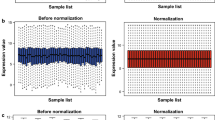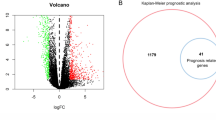Summary
Esophageal cancer is a common malignant tumor, whose pathogenesis and prognosis factors are not fully understood. This study aimed to discover the gene clusters that have similar functions and can be used to predict the prognosis of esophageal cancer. The matched microarray and RNA sequencing data of 185 patients with esophageal cancer were downloaded from The Cancer Genome Atlas (TCGA), and gene co-expression networks were built without distinguishing between squamous carcinoma and adenocarcinoma. The result showed that 12 modules were associated with one or more survival data such as recurrence status, recurrence time, vital status or vital time. Furthermore, survival analysis showed that 5 out of the 12 modules were related to progression-free survival (PFS) or overall survival (OS). As the most important module, the midnight blue module with 82 genes was related to PFS, apart from the patient age, tumor grade, primary treatment success, and duration of smoking and tumor histological type. Gene ontology enrichment analysis revealed that “glycoprotein binding” was the top enriched function of midnight blue module genes. Additionally, the blue module was the exclusive gene clusters related to OS. Platelet activating factor receptor (PTAFR) and feline Gardner-Rasheed (FGR) were the top hub genes in both modeling datasets and the STRING protein interaction database. In conclusion, our study provides novel insights into the prognosis-associated genes and screens out candidate biomarkers for esophageal cancer.
Similar content being viewed by others
References
Chen W, Zheng R, Zeng H, et al. Annual report on status of cancer in China, 2011. Chin J Can Res (Chinese), 2015,27(1):2–12
Blot WJ, McLaughlin JK. The changing epidemiology of esophageal cancer. Semin Oncol, 1999,26(5 Suppl 15):2–8
Langfelder P, Horvath S. WGCNA: an R package for weighted correlation network analysis. BMC Bioinformatics, 2008,9:559
Zhang J, Baddoo M, Han C, et al. Gene network analysis reveals a novel 22-gene signature of carbon metabolism in hepatocellular carcinoma. Oncotarget, 2016,31(7):49232–49245
Presson AP, Yoon NK, Bagryanova L, et al. Protein expression based multimarker analysis of breast cancer samples. BMC Cancer, 2011,11:230
Upton A, Arvanitis TN. Using evolutional properties of gene networks in understanding survival prognosis of glioblastoma. IEEE T Inf Technol B, 2014,18(3):810–816
Zhao X, Cai H, Wang X, et al. Discovery of signature genes in gastric cancer associated with prognosis. Neoplasma, 2016, 63(2):239–245
Jia X, Miao Z, Li W, et al. Cancer-risk module identification and module-based disease risk evaluation: a case study on lung cancer. PloS one, 2014,9(3):e92395
Wan YW, Allen GI, Liu Z. TCGA2STAT: simple TCGA data access for integrated statistical analysis in R. Bioinformatics, 2016,32(6):952–954
Huber W, Carey VJ, Gentleman R, et al. Orchestrating high-throughput genomic analysis with Bioconductor. Nat Methods, 2015,12(2):115–121
Hastie T, Narasimhan B, Chu G. Impute: Imputation for microarray data. In R package version 1.46.0, 2016
Kosinski M, Biecek P. RTCGA: The cancer genome atlas data integration. In R package version 1.2.2, 2015
Langfelder P, Horvath S. Fast R functions for robust correlations and hierarchical clustering. J Stat Softw, 2012,46(11):i11
Langfelder P, Horvath S. Eigengene networks for studying the relationships between co-expression modules. BMC Syst Biol, 2007,1:54
Lopez-Raton M, Rodriguez-Alvarez MX, Cadarso-Suarez C et al. Optimal cutpoints: An R package for selecting optimal cutpoints in diagnostic tests. J Stat Softw, 2014,61(8):1–36
Hu Z, Hung JH, Wang Y, et al. VisANT 3.5: multi-scale network visualization, analysis and inference based on the gene ontology. Nucleic Acids Res, 2009,37:W115–W121
Jensen LJ, Kuhn M, Stark M, et al. STRING 8-a global view on proteins and their functional interactions in 630 organisms. Nucleic Acids Res, 2009,37:D412–D416
Jacomy M, Venturini T, Heymann S, et al. ForceAtlas2, a continuous graph layout algorithm for handy network visualization designed for the Gephi software. PloS one, 2014,9(6):e98679
Fang H, Gough J. The ‘dnet’ approach promotes emerging research on cancer patient survival. Genome Med, 2014,6(8):64
Chase PB, Yang JM, Thompson FH, et al. Regional mapping of the human platelet-activating factor receptor gene (PTAFR) to 1p35->p34.3 by fluorescence in situ hybridization. Cytogenet Cell Genet, 1996,72(2–3):205–207
Agrawal V, Jaiswal MK, Ilievski V, et al. Platelet-activating factor: a role in preterm delivery and an essential interaction with Toll-like receptor signaling in mice. Biol Reprod, 2014,91(5):119
Wang Q, An Y, Yuan Q, et al. Identification of allelic expression imbalance genes in human hepatocellular carcinoma through massively parallel DNA and RNA sequencing. Med Oncol, 2016,33(4):38
Kim HS, Han HD, Armaiz-Pena GN, et al. Functional roles of Src and Fgr in ovarian carcinoma. Clin Can Res, 2011,17(7):1713–1721
Hu Y, Liu Y, Pelletier S, et al. Requirement of Src kinases Lyn, Hck and Fgr for BCR-ABL1-induced B-lymphoblastic leukemia but not chronic myeloid leukemia. Nat Genet, 2004,36(5):453–461
Liu Y, Bezverbnaya K, Zhao T, et al. Involvement of the HCK and FGR src-family kinases in FCRL4-mediated immune regulation. J Immunol, 2015,194(12):5851–5860
Author information
Authors and Affiliations
Corresponding author
Rights and permissions
About this article
Cite this article
Zhang, C., Sun, Q. Weighted gene co-expression network analysis of gene modules for the prognosis of esophageal cancer. J. Huazhong Univ. Sci. Technol. [Med. Sci.] 37, 319–325 (2017). https://doi.org/10.1007/s11596-017-1734-8
Received:
Revised:
Published:
Issue Date:
DOI: https://doi.org/10.1007/s11596-017-1734-8




